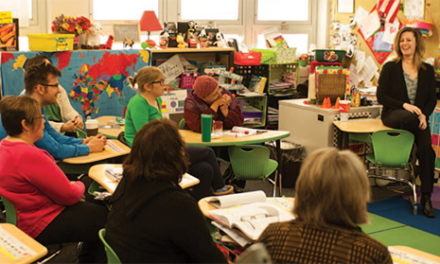Teachers share the challenges they faced when they had to quickly move classes online.
Since early March 2020, the COVID-19 viral pandemic has affected all facets of American life, including school operations. On March 12, 2020, the Centers for Disease Control and Prevention issued revised guidance on handling COVID-19 in schools. That same day, Michigan became the first state to close its public schools due to the pandemic (Ballotpedia, 2020), and by March 23, all but two states had followed suit. The last two, Nebraska and Maine, did so on April 1 and 2.
Most school districts shifted to online instruction. Some opted for a kind of hybrid model, supplementing online instruction by sending packets of worksheets to students who lacked internet access. But whatever the local approach to remote teaching and learning, the nature of teachers’ work shifted radically, and practically overnight. How did they cope, personally and professionally, with such an abrupt change? To find out, we surveyed hundreds of teachers from mid-March to early April, while they were in the midst of the initial transition from teaching in classrooms to teaching from home.
Emergency remote teaching
Before we turn to our findings, it’s important to distinguish between the regular, planned practice of online instruction and the kind of instruction that occurred immediately after schools were shuttered. Previous research has shown that while many teachers find online instruction to be rewarding, those who are new to it tend to report having to deal with increased workloads and a variety of challenges related to using the technology, communicating with students, organizing synchronous sessions, and measuring student outcomes (Choi & Park, 2006; Conceição, 2006). These difficulties tend to occur with any transition to online teaching, no matter how gradual.
However, what took place this spring was no ordinary transition, and what occurred wasn’t online instruction per se — it is more accurate to describe it as emergency remote teaching (ERT), defined as “a temporary shift of instructional delivery to an alternate delivery mode due to crisis circumstances” (Hodges et al., 2020). ERT is distinct from ordinary online teaching and learning, in which virtual experiences and online instruction have been planned from the beginning (Affouneh, Salha, & Khlaif, 2020; Hodges et al., 2020; Milman, 2020a). Many of the challenges novice online teachers experience under normal circumstances are likely to be greatly exacerbated in an emergency situation, such as COVID-19.
The distinction between ERT and online learning is crucial. While advocates have made great efforts “to promote online learning as a viable, sustainable, valuable method of teaching and learning” (Manfuso, 2020), many people continue to view it as inherently inferior to face-to-face instruction. And some might be tempted to assume that the remote instruction offered in spring 2020 was typical of online instruction in general — validating their assumption that teaching online is not as effective as teaching in a classroom — but that would be an unfair comparison (Hodges et al., 2020).
In short, the extraordinary circumstances teachers faced in light of the pandemic prevented them — and their students — from making a normal transition to remote education. Further, the circumstances took a toll on student learning for reasons that had nothing to do with the online medium itself. In light of the situation, some experts advised instructors to reduce their students’ workloads, as well as their own. As one argued, “We’re all operating in the shadow of a global pandemic, and it is disorienting and limiting . . . [To proceed with] business as usual is unrealistic” (Merrill, 2020). Acknowledging that “these are not normal teaching and learning conditions,” Natalie Milman (2020b) suggested that school leaders and educators prioritize needs by establishing short- and long-term priorities, being flexible with policies and practices, and collaborating in online communities to support one another. That is, educators had good reason to pull back on academic expectations, whatever form of instruction they used.
Our goal, then, is not to judge the effectiveness of the online instruction that teachers provided this spring but, rather, to understand the challenges — and, at times, successes — teachers experienced during the early days of the COVID-19 pandemic. Ideally, we can use what we’ve learned from the spring 2020 transition to develop strategies for helping teachers make smoother transitions to online instruction, whether they do so suddenly or through a more gradual and well-planned process.
Teachers weigh in
From mid-March to early April 2020, we surveyed teachers about their experiences during the transition to remote instruction. We asked teachers which aspects of teaching were the most challenging during this time and how prepared they felt for delivering instruction remotely. We distributed an anonymous link to our survey using our personal networks of teachers. We also shared the survey on social media networks including Facebook and Reddit and invited those employed as a preK-12 teacher to participate. Our aim was not to find fault or assign blame; however, we felt it was important to learn from this moment in history.
A total of 328 teachers participated in the study; they predominantly identified as white (89.4%) and female (83.7%) and had an average age of 39.9 years. The average participant had been teaching at their current school for 7.1 years and had been in the profession for 11.6 years. More than half of our sample (56.6%) indicated that they teach in a Title I school. More than one-third (36.6%) teach in a school located in a suburban setting; about a quarter teach in rural (24.1%) and urban settings (25.7%); and about 1 in 7 (13.5%) teach in a small town.
Challenges of teaching remotely
A large majority (92.4%) of teachers indicated that they had never taught online before the emergency transition, and very few had received any meaningful training from their school or school district. As one teacher explained, “All of my pedagogical training assumed that teaching would take place in a face-to-face environment.” Teachers shared that most of what they learned was from each other and from their own individual research. This complements the findings of Catherine Cavanaugh and Abraham DeWeese (2020), who found that views for online educator support sites for the chat and video platform Microsoft Teams increased more than sixfold between February and March 2020. Despite their inexperience and lack of formal training, however, almost half (49%) of teachers we surveyed felt at least somewhat prepared to deliver instruction remotely.
We asked teachers to rate several aspects of their professional work (including lesson planning, assessing student learning, engaging with parents, and differentiating instruction) on a six-point scale, from (1) much more challenging during face-to-face instruction to (6) much more challenging during remote instruction. Respondents rated all of the job functions included in the survey to be more challenging remotely.
A pair of open-ended items asked teachers to describe barriers they experienced providing instruction to their students, as well as barriers to receiving instruction that they believed their students to be experiencing. Overall, teachers responded that they had difficulty providing quality instruction with an appropriate amount of rigor during the pandemic. They said they lacked adequate time to do the job well and in some cases lacked access to many of their pedagogical materials that were still at school.
The most common response from teachers was that they lacked the ability to hold students accountable. Many school systems changed grading procedures so that students could not earn a lower grade than they had before the pandemic (Sawchuk, 2020), and while this policy was meant to address concerns related to equity of access, it also removed an extrinsic motivator for students who did have the means to complete assignments successfully. A 5th-grade suburban elementary school teacher wrote: “I cannot hold students accountable for submitting their work. I cannot give grades . . . I cannot meet with students via video conferencing unless they request it. . . . I cannot teach anything new.” Another teacher noted that only nine of her 109 students attended her synchronous Zoom lessons, yet everyone would receive an A for the course.
Limited technology services also made it more difficult for teachers to provide meaningful feedback and interact directly with their students. Noting that her school made it possible to provide only asynchronous lessons, an elementary school teacher from New York pointed out that “Students are not able to ask me direct questions because my lessons are videotaped and [they] watch them at their convenience.” Several other teachers shared similar sentiments, noting that the inability to have real-time interactions hindered their ability to teach.
Teachers of music, art, and physical education faced special challenges. In some cases, they were asked not to assign any homework, so as “to let students focus on their ‘core’ classes” (English, math, science, and social studies). A teacher from Indiana explained, “It’s very difficult to teach primary (K-2) students engaging music lessons without being physically together, and they’re missing the fundamentals of music education.” Several art teachers told us that even when their students had access to technology, the internet, and other supplies like pencils, they often lacked the art supplies necessary to participate in the types of instructional activities they would typically assign.
For many teachers, the lack of real-time communication made it difficult to keep students motivated, especially younger students. An elementary special education teacher said that “it’s difficult to motivate [my students] online when each is motivated differently.” An elementary art teacher from Virginia echoed these sentiments, noting the importance of spending time with students to motivate them to learn: “It is difficult to communicate with students when we have no classroom time with them.” Teachers found it especially difficult to meet the needs of English language learners and students with special needs.
Challenges outside school
Many teachers noted also that their personal circumstances made it even more difficult to shift from in-person to online instruction. A 3rd-grade special education teacher from Connecticut wrote:
I have three children of my own (ages 16, 14, 5) [who] all are learning from home. The two oldest are able to complete schoolwork without my assistance, but they need devices during the same time of the day. My 5-year-old needs me to sit with him while working on his work to help guide him and if he needs to log in to complete a task, then another device is being utilized. I am overwhelmed creating new lessons in a way I’ve never done before, trying to teach myself new ways to interact with my students, and trying to make sure my own children are taken care of and completing their work with limited devices at home.
The extraordinary circumstances teachers faced in light of the pandemic prevented them — and their students — from making a normal transition to remote education.
As this teacher’s quote suggests, the challenges teachers faced tended to be interconnected. For example, having children at home required teachers to juggle their own work and their children’s educational and technological needs. Several teachers, particularly those in rural areas, shared that they did not have reliable internet access at home.
Both teachers and students faced challenges on multiple fronts throughout this volatile period. In many cases, students had other needs (such as food security) that took priority over school, if they could access online instruction at all. A 1st-grade teacher from Alabama told us that only 5 of her 20 students were using online instruction, a fact she attributed to a lack of internet access at home. Unfortunately, her experience was not unusual. Indeed, more than half of the teachers we surveyed (57.2%) indicated that at least one-fourth of their students lacked access to broadband internet outside school. And many students who had access to the internet had to compete with multiple siblings to use their internet-enabled devices for schoolwork.
Recommendations
The most important recommendation our survey participants made was for schools to regularly incorporate “digital learning days” into the school year to help them prepare for any sudden shift to remote instruction. A veteran high school social studies teacher said, “There needs to be some instruction during a regular school year that includes technology being used at home so it isn’t new during these emergency situations.” An elementary school art teacher concurred, adding that students should be graded as usual on these days (provided the school could ensure online access), so that they “feel this is important.” This kind of planning, teachers pointed out, will be useful in the event of extended school closures due to snow, natural disaster, sickness, or any other reason.
The need to prepare for emergencies was a common theme among the teachers who participated in our survey. They recommended that schools develop clear guidelines and procedures for grading; checking in regularly with staff and parents; providing food, support, and computer access to lower-income families; delivering remote instruction effectively to elementary-age children and students with special needs, and assisting any student who has trouble setting up and using online services.
The sudden shift to remote instruction during the pandemic was unprecedented, and we believe it is important to capture teachers’ experiences. Our findings suggest that teachers found several aspects of teaching to be more difficult during ERT than during face-to-face instruction. Survey results also offered a sober but important reminder that teachers are human beings with lives and obligations beyond their professional role. By better understanding their experiences and heeding their recommendations, we hope that schools might be better prepared for future emergencies and provide better support for both teachers and students in an online setting.
References
Affouneh, S., Salha, S., & Khlaif, Z.N. (2020). Designing quality e-learning environments for emergency remote teaching in coronavirus crisis. Interdisciplinary Journal of Virtual Learning in Medical Sciences, 11 (2), 1-3.
Ballotpedia. (2020). School closures in response to the coronavirus (COVID-19) pandemic, 2020. https://ballotpedia.org/School_closures_in_response_to_the_coronavirus_(COVID-19)_pandemic_2020
Cavanaugh, C. & DeWeese, A. (2020). Understanding the professional learning and support needs of educators during the initial weeks of pandemic school closures through search terms and content use. Journal of Technology and Teacher Education, 28 (2), 233-238.
Choi, H.J. & Park, J.H. (2006). Difficulties that a novice online instructor faced: A case study. Quarterly Review of Distance Education, 7 (3), 317.
Conceição, S.C. (2006). Faculty lived experiences in the online environment. Adult Education Quarterly, 57 (1), 26-45.
Hodges, C., Moore, S., Lockee, B., Trust, T., & Bond, A. (2020, March 27). The difference between emergency remote teaching and online learning. Educause Review.
Manfuso, L.G. (2020, May 7). From emergency remote teaching to rigorous online learning. EdTech.
Merrill, S. (2020, March 19). Teaching through a pandemic: A mindset for this moment. Edutopia.
Milman, N. (2020a, March 25). Pandemic pedagogy. Phi Delta Kappan.
Milman, N. (2020b, March 30). This is emergency remote teaching, not just online teaching. Education Week.
Sawchuk, S. (2020, April 1). Grading students during the coronavirus crisis: What’s the right call? Education Week.
ABOUT THE AUTHORS

David M. Shannon
David M. Shannon is Humana-Germany-Sherman Distinguished Professor at Auburn University, Auburn, AL.

David T. Marshall
David T. Marshall is an assistant professor of educational research and at Auburn University, Auburn, AL. He is the editor of COVID-19 and the Classroom: How Schools Navigated the Great Disruption.

Savanna M. Love
SAVANNA M. LOVE is a visiting assistant professor of education at Randolph-Macon College, Ashland, VA.










